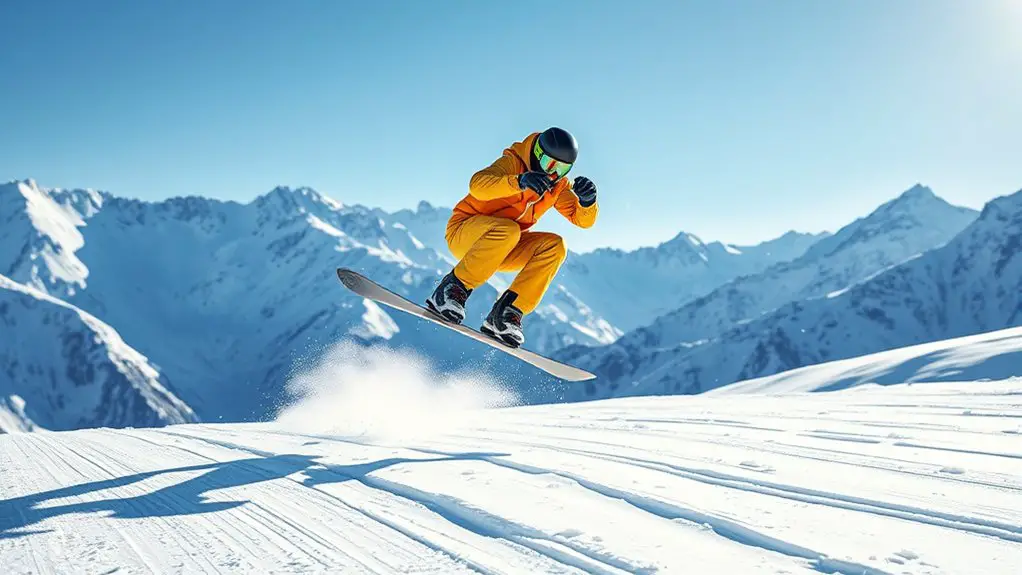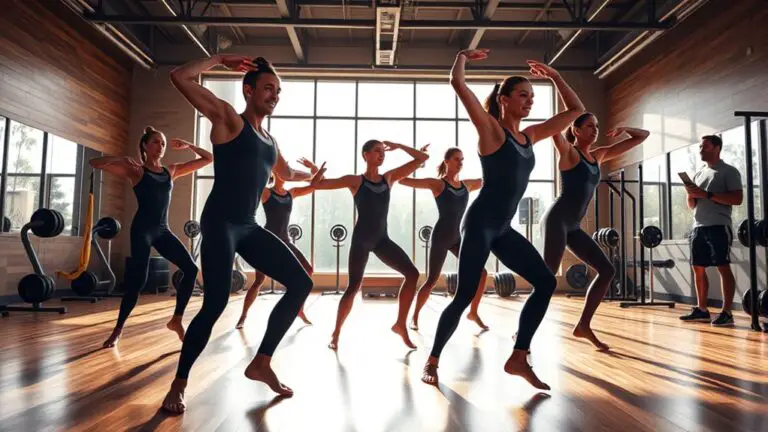The Best Plyometric Exercises for Snowboarding Athletes

If you want to boost your snowboarding skills, incorporate plyometric exercises like box jumps and depth jumps. These moves build explosive power and reactive strength, essential for those tricky slopes. Add lateral bounds for improved agility, and try single-leg hops to enhance your stability. Tuck jumps help maximize your leg power. By consistently practicing these exercises, you’ll see increased performance on the slopes. Discover other effective techniques that can elevate your game even further.
Box Jumps: Building Explosive Power

Box jumps are an important plyometric exercise for snowboarding athletes, as they not only enhance explosive power but also improve overall coordination and agility. By incorporating box jumps into your training regimen, you can greatly boost your power development, which is vital for executing jumps and tricks on the slopes.
To perform a box jump effectively, focus on your jump technique. Start with your feet shoulder-width apart and bend your knees slightly. Swing your arms back, then explosively drive them forward as you jump onto the box, landing softly with your knees slightly bent. This proper landing technique helps prevent injury while maximizing your power output.
Consistency is key. Aim for multiple sets, gradually increasing the height of the box as you improve. Remember, the explosive power you build through box jumps directly translates to better performance and control during your snowboarding sessions, making this exercise a valuable addition to your training plan.
Depth Jumps: Enhancing Reactive Strength
When aiming to enhance reactive strength for snowboarding, depth jumps are an excellent plyometric exercise to incorporate into your training routine. This powerful movement helps you develop explosive agility, essential for maneuvering the slopes. Here are four key depth jump techniques and their reactive strength benefits:
- Proper Landing Mechanics: Focus on soft landings to minimize injury risk and maximize strength gains.
- Jump Height: Use varying heights to challenge your muscles and stimulate growth.
- Plyometric Progression: Start with lower heights and gradually increase as you master the technique.
- Quick Turnaround: Minimize ground contact time to enhance your explosiveness and reaction speed.
Lateral Bounds: Improving Agility and Balance

To improve your agility and balance on the slopes, incorporating lateral bounds into your training is essential. This plyometric exercise targets lateral agility, vital for quick direction changes while snowboarding. Begin by standing on one leg, then jump sideways as far as possible, landing softly on the opposite leg. Focus on controlling your landing to enhance balance, a key component in maintaining stability during your runs.
Lateral bounds not only develop explosive power but also engage your core and lower body, reinforcing the muscles necessary for effective balance drills. As you progress, increase the distance and speed of your bounds to challenge yourself further. Incorporating this exercise into your routine will help you navigate challenging terrains with confidence and ease. Consistent practice will lead to improved performance, helping you dominate the slopes while minimizing the risk of injury. So, add lateral bounds to your workout and experience the benefits firsthand!
Single-Leg Hops: Strengthening Stability
Engaging in single-leg hops can greatly enhance your stability and strength, crucial for maintaining balance while snowboarding. This exercise focuses on the single leg technique, imperative for performing complex maneuvers on the slopes. Here’s how to optimize your stability training with single-leg hops:
- Start slow: Begin with controlled hops to gauge your balance.
- Focus on form: Keep your landing soft and stable, engaging your core.
- Increase intensity: Gradually add height and distance to your hops.
- Track progress: Record your performance to see improvements over time.
Incorporating single-leg hops into your routine will not only bolster your strength but also help prevent injuries. The enhanced stability you gain will translate directly to better control and maneuverability while snowboarding, allowing you to tackle challenging terrain with confidence. Remember, consistent practice is key to mastering this crucial plyometric exercise.
Tuck Jumps: Boosting Overall Leg Power

Tuck jumps are an excellent way to enhance overall leg power, which is vital for snowboarding performance. By engaging multiple muscle groups, they improve explosive strength and agility. To perform a tuck jump, maintain proper plyometric form: stand with your feet shoulder-width apart, bend your knees, and jump explosively while bringing your knees to your chest. Landing softly is essential to minimize impact and maintain balance.
You can incorporate tuck jump variations, like lateral tuck jumps or single-leg tuck jumps, to target different muscle groups and add variety to your workout. These variations challenge your stability and coordination, important for maneuvering diverse snowboarding terrains. Aim for three sets of 8-12 repetitions, focusing on height and form. Integrating tuck jumps into your training regimen will not only boost your leg power but also enhance your overall snowboarding performance, allowing for quicker turns and more powerful jumps on the slopes.
Frequently Asked Questions
How Often Should Snowboarders Incorporate Plyometric Exercises Into Their Routine?
Imagine launching off a snowy ramp, feeling the rush as you soar through the air. To keep that thrill alive, you should incorporate plyometric exercises into your routine about 2 to 3 times a week. This frequency recommendation balances intensity and recovery, fitting seamlessly into most training schedules. By making plyometrics a regular part of your regimen, you’ll enhance your explosive power, agility, and overall performance on the slopes.
What Is the Ideal Warm-Up Before Performing Plyometric Exercises?
Before diving into plyometric exercises, you should focus on a proper warm-up. Start with dynamic stretches to increase blood flow and flexibility, targeting major muscle groups. Incorporate mobility drills to enhance joint range of motion, which prepares your body for explosive movements. Aim for at least 10-15 minutes of this warm-up routine to guarantee you’re ready to perform safely and effectively, minimizing the risk of injury while maximizing your performance.
Can Beginners Safely Perform These Plyometric Exercises?
Yes, beginners can safely perform plyometric exercises, but it’s essential to prioritize safety. Start with low-impact variations to build strength and coordination. You should focus on proper form and gradually increase intensity. Exercise modifications, like reducing jump height or using softer surfaces, can help minimize injury risks. Always listen to your body; if something feels off, take a step back. With patience and the right approach, you’ll develop the skills needed for more advanced movements.
Are There Any Specific Cool-Down Stretches After Plyometric Workouts?
After a high-energy plyometric session, it’s essential to cool down like a race car easing into the pit. Effective cool down techniques include gentle stretching routines to help your muscles recover and prevent stiffness. Focus on dynamic stretches targeting the legs, hips, and back. Incorporate hamstring stretches, quadriceps stretches, and calf stretches. These help maintain flexibility and promote circulation, ensuring your body shifts smoothly from intense activity to a restful state.
How Do Plyometric Exercises Benefit Overall Snowboarding Performance?
Plyometric exercises greatly enhance your snowboarding performance by focusing on power development and explosive strength. These exercises improve your ability to generate force quickly, which is essential for maneuvers like jumps and turns. By training your muscles to contract rapidly, you’ll notice increased agility and responsiveness on the slopes. Incorporating plyometrics into your routine helps build the necessary strength and endurance, allowing you to tackle more challenging runs with confidence and skill.





